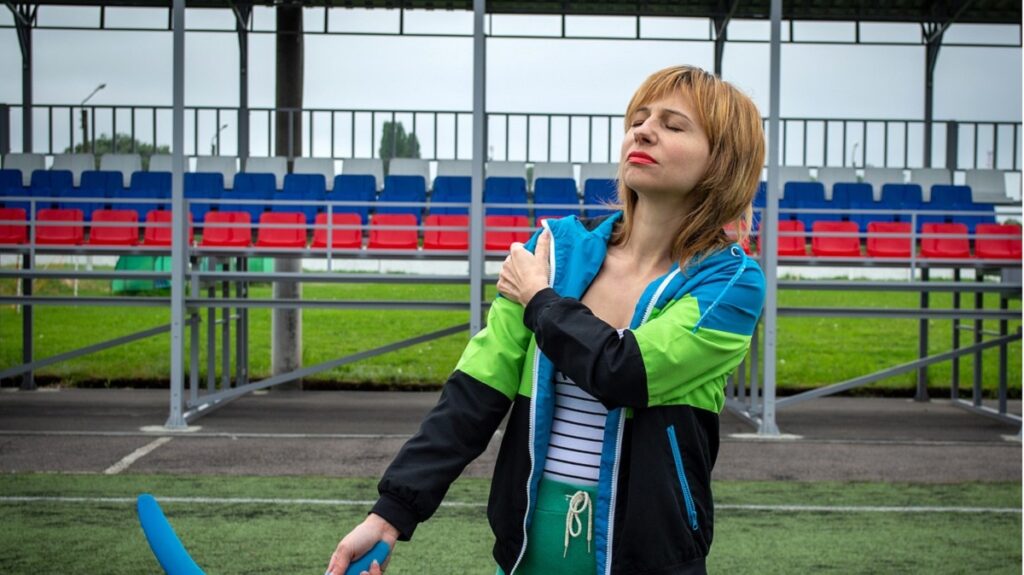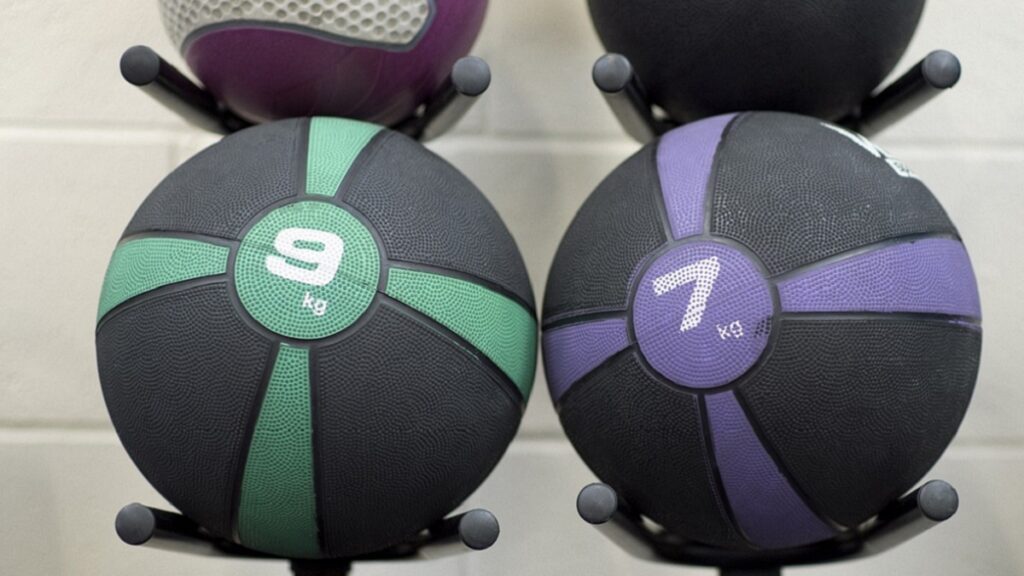Hyperextended shoulder exercises are physical therapies that restore shoulder stability and strength after a case of hyperextension. So, what’s shoulder hyperextension to begin with? It’s a form of injury where the shoulder joint is stretched beyond its usual range of motion.
You treat a hyperextended shoulder by reducing its movement with a sling or splint and then restoring its strength and range of motion through physical exercises. A hyperextended shoulder normally takes one to eight weeks to recover, but severe cases take up to six months. The fastest way to heal a strained shoulder is by immobilizing and resting it.
Shoulder hyperextension is a broad subject. Luckily, I’ve broken it down for you. Read on for a deeper insight!
What Is Shoulder Hyperextension?
Shoulder hyperextension is the rotation of the shoulder joint beyond its usual range of motion. It mainly affects the rotator cuff tissues that keep the upper arm bone in its socket. Severe cases of hypertension involve the tearing of ligaments which leads to shoulder joint dislocation.
Once the shoulder joint ligaments strain or tear, they loosen their tension on the humerus. Subsequently, the head of the upper arm bone shifts out of its place.
The rotator cuff may tear instantly from extreme impact, strain from accidents, or gradually through sporting activity. Swimming, kayaking, and throwing the javelin involve an over-rotation (moving beyond its usual path) of the shoulder joint.
Such motions cause shoulder impingement—rubbing the rotator cuff tissues against nearby tissues or bones. In the end, the rotator cuff tendons or muscles get inflamed and painful.
Rotator cuff tears from acute injury cause a sudden severe pain in the shoulder that increases at night or when the arm remains in a static position. The arm loses strength, and you can hardly raise it due to pain.
On the other hand, degenerate tears develop and get worse with time, and so does the pain. It all starts with mild pain that improves with OTC painkillers. However, the pain becomes unbearable with time and doesn’t respond to painkillers.
Hyperextended Shoulder Exercises
Hyperextended shoulder exercises are shoulder-specific exercises that help recover faster from hyperextension injuries. The workout program involves mobility exercises that restore your shoulder’s ability to move through its full range of motion. Besides, they reduce joint tightness and make it flexible once again.
Helpful Exercises for Rehabilitation from Shoulder Hyperextension
The following exercises will help you recover well from shoulder hyperextension injuries. However, if you’re recovering from surgery, it’s vital to seek the services of a physical therapist to help you do the right exercises.
Pendulum Swing Exercise
Support the arm without injury on a table. Lean over such that the injured arm dangles from your body. Move your body from the waist so the relaxed arm swings gently from the shoulder. Repeat several times with short intervals of rest.
Squeezing The Scapula
Position your arms on either side of the body. Rotate your arms from the shoulder such that they press your shoulder blades together.
Shoulder Blade Protraction and Retraction
This exercise works well if you stand upright with your arms on the sides. In that position, rotate your arms (protract) such that you push your shoulder blades forward. Return your arms to the starting position.
Now rotate your arms in the opposite direction (retract) such that you force your shoulder blades back together.
Shoulder Shrugs
A shoulder shrug is a movement of your shoulder joint towards your ears. You hold the shoulder up for a few seconds before releasing. The exercise helps in restoring shoulder joint strength.
Internal rotation of the Shoulder joint
Internal rotation exercise works well whether you’re seated or standing. Hold a towel or long heavy cloth at the back of your body. Let each of your arms hold either end of the towel or cloth. Now move the injured arm towards the opposite side and back several times.
Raising The Dumbells
Weight lifts strengthen your rotator cuff muscles during recovery. However, starting with light weight is advisable to avoid injuring yourself.
Lean over and support yourself with one hand on a low table or bed. Lift a dumbbell with the other hand until the elbow is fully bent. Repeat three sets of 10 lifts.
You may add as much weight as you can tolerate. The best weights for a start range between 3-5 lbs.
Safety Tips During Hyperextended Shoulder Exercise
Although exercises are crucial to shoulder recovery, observing some safety precautions is vital to keep yourself from fresh injuries. These are the safety tips:
- Stop the exercise if it’s painful: It’s normal to experience slight discomfort while exercising. However, a sharp pain shows that your body is straining and is a vital signal to keep you from a fresh injury.
- Start slowly: Don’t do too much on your first day. Give your shoulder time to adjust. Start with a few workouts and increase the number and intensity of workouts
as your body builds strength.
- Maintain a proper posture: Maintain a neutral spine posture when working out. Do not slouch. Poor posture strains your tissues and bones.
- Watch your hands: According to physical therapist Wendy Sany, keeping your hands within your peripheral vision when doing overhead lifts or pressing exercises like push-ups is advisable. Drifting your hands out of your vision results in poor posture, which may cause injury.
- Consult your physical therapist: It’s essential to seek medical advice from your doctor if you’ve had surgery or are in intense pain before engaging in any shoulder mobility exercise.
How Do You Treat a Hyperextended Shoulder?
You treat a hyperextended shoulder by immobilizing and resting the shoulder. Besides, physical therapy is applied to the affected shoulder to strengthen it and help it recover from its limited range of motion. Surgery comes as the last option for severe cases of hyperextension.
When the injury is fresh, you may apply ice if you cannot bear the inflammation. Once the pain and swelling subside, it’s essential to seek medical advice on the exercise program that best fits the nature of your injury. However, the program comes after some rest of a day or two to avoid worsening the injury.
On the other hand, the physical therapist may need to understand the extent of your injury to offer the right therapy. For instance, some hyperextension cases come with shoulder dislocations. For such cases, a gentle pull is first needed to fix the joint in its place. Physical therapy can now follow.
When Is Surgery Needed?
Surgery is the last option if the injured joint is not responding to other treatments. However, the shoulder injury must meet several other criteria to justify surgery. For instance, if the hyperextension involves rotator cuff tears, a specialized repair only achieved through surgery is crucial.
Besides, the doctor may recommend surgery if you’re a professional athlete or use your shoulder in your job.
If the head of the humerus pops out of its socket repeatedly, you have torn ligaments. Such cases also need surgery to fix.
The RICE Method of Treating Hyperextension
Most athletes rely on the RICE technique to treat minor sports injuries that don’t need the attention of a specialist. However, the RICE method is best suited for acute injury. Some doctors will recommend it as the first treatment to reduce swelling, relieve pain, and speed up recovery.
The acronym RICE stands for:
- Rest: In as much as you need to move your injured shoulder, it’s advisable to rest it for at least two days. When an injury is fresh, the muscles are still weak and prone to further injury. Even after the rest, you need to use the joint gradually. Once you rest an injury, the healing process starts well.
- Ice: Applying ice on an injury is beneficial the first day or two after suffering an injury. You may crash some ice or freeze some veggies in a bag, which you then place on your injured shoulder. It’s crucial to note that you should not bring your skin in contact with the ice. Ice decreases blood flow to the injured area and thus relieves pain and reduces swelling. After icing your shoulder for around 15 minutes, allowing your skin to adjust to normal temperature before icing again is advisable.
- Compression: Wrapping an elastic bandage or sock around your injury prevents fluid buildup and lessens the swelling. However, you should make sure that the wrapping is not so tight that it causes you some numbness due to decreased blood flow.
- Elevation: Elevating the injured spot above your heart’s level helps drain fluids away to reduce swelling. However, this works perfectly for knee and ankle injuries.
How Long Does a Hyperextended Shoulder Take to Heal?
A hyperextended shoulder takes a few weeks to several months to heal. The time it takes to heal depends on how severe the injury is.
For mild shoulder injuries, you may recover within one to two weeks and be able to resume your normal activities. It usually takes six to eight weeks for moderate shoulder injuries to resume daily activities involving the shoulder. However, this is the case if you have enough rest and proper physical therapy.
Severe shoulder injuries like ligament and tendon tears take longer to heal. Their recovery usually takes four to eight weeks. However, it may take another three to six months of rehabilitation before using your shoulders for any regular activity. If the injury requires surgery, you will need more months to recover.
What Factors Speed Up Shoulder Recovery?
Simple lifestyle changes shorten the healing time. Regular rest, icing, and compressing the injured area until the swelling subsides helps start off the recovery well.
Furthermore, restricting the movement of the injured shoulder also helps quicken the recovery process. A physical therapy program caps it all by restoring the shoulder’s muscle strength and range of motion.
What Factors Slow Down Shoulder Recovery?
Extreme shoulder motion and heavy lifting are likely causes of re-injury. It’s good to give your body time to recover.
Unfortunately, age is also a factor that slows down shoulder recovery. As we grow older, the body’s ability to fight for itself dwindles, causing longer recovery times. In this case, the pain may become chronic and require a specialist’s intervention.
What Is the Fastest Way to Heal a Strained Shoulder?
The fastest way to heal a strained shoulder is through resting, compressing, elevating, and applying ice. Restricting its movement is also vital to keep it from more injury. Moreover, you need physical therapy to strengthen the shoulder and boost its range of motion.
Proper rest after injury sets a good starting point for recovery. Compression, applying ice, and elevating the joint reduces swelling and pain. However, if the pain is severe, painkillers can be used.
Although recovery times depend on the severity of an injury, they can be shortened by lifestyle changes.
Your body is a system. Therefore, enough sleep, proper hydration, and a healthy diet improve your well-being, shortening recovery periods.
Will A Hyperextended Shoulder Heal on Its Own?
Yes, a hyperextended shoulder can heal on its own. However, it’s minor hyperextension injuries that heal on their own if proper self-care measures are observed. Severe injuries that involve deformity and extreme pain require medical attention coupled with physical therapy for proper healing. For some injuries, surgery is needed.
According to Dr. Andrew Dutton, a shoulder dislocation cannot heal on its own. You need a doctor’s intervention to push the head of the humerus back to its socket. Leaving it untreated exposes the nearby tissues to damage.
What Happens If You Hyperextend Your Shoulder?
When you hyperextend your shoulder, the joint is forced to extend beyond its usual range of motion by immense force or impact. The strain damages the tissues surrounding a joint and thus causes inflammation and extreme pain. Besides, the joint becomes weak and unstable.
When you force a joint beyond its normal range, the tissues surrounding the joint, like tendons, muscles, and ligaments, may become damaged. In normal cases, it’s only the muscles and tendons that overstretch.
Usually, mild cases of shoulder hyperextension affect the rotator cuff muscles and the shoulder socket joint. According to certified trainer Rick Rockwell, shoulder joint hyperextension usually affects the supraspinatus and infraspinatus rotator cuff muscle groups.
In more severe cases of hyperextension, the joint becomes unstable due to the tearing of ligaments. The joint weakens because the ligaments connect one shoulder joint bone to another. Such tears cause severe pain that worsens with the movement of the joint.
Furthermore, a bone weakly held by a torn ligament may dislocate and cause more shoulder injuries.
Does Over-Rotation Cause Shoulder Hyperextension?
Yes, over-rotating the shoulder is a common cause of shoulder hyperextension. Some cases of hyperextension are caused by either excessive internal rotation or external rotation of the shoulder joint.
Generally, over-rotation of the shoulder joint is caused by but not limited to activities that require a strenuous repetitive motion of the shoulder joint. Sporting activities like swimming, bowling, and throwing the javelin, to mention a few, are common causes due to over rotation.
The strenuous repetitive motion causes shoulder impingement, a rotator cuff injury caused by rubbing the rotator cuff tendon with nearby tissue and bones.
Should You Stretch a Hyperextended Shoulder?
Yes, you should stretch a hyperextended shoulder, but you need to consult a physical therapist on the right way of doing it. Stretching promotes shoulder healing by helping the shoulder regain its flexibility and range of motion.
However, for severe injuries, stretching may cause further damage if done too early or wrongly. Furthermore, you should only focus on exercises that strengthen the shoulder but not those that force it back to the hyperextended position.
What Does Hyperextending Your Shoulder Feel Like?
Hyperextending your shoulder comes with sharp shoulder pain and tenderness, which is followed by arm weakness and shoulder instability. With a hyperextended shoulder, you can hardly move the arm due to intense pain.
What Damage Can Hyperextension Cause?
Hyperextension can cause a variety of injuries at or near joints. The more common ones are sprains and strains of tendons, muscles, and ligaments. In some cases, it rubs or pulls off cartilage out of its place. All of these injuries have common results—intense pain, difficulty in moving the arm, and joint instability.
Where the hyperextension tears the ligaments, dislocation follows. Since ligaments hold bones together, when they tear, the bones leave their usual places due to diminished support.
When hyperextension reaches the nerves of your arms and fingers, they become numb and too weak to lift anything. Furthermore, they develop a tingling sensation that keeps you uncomfortable.
Ultimately chronic hyperextension may slowly degenerate a joint, making it stiff and painful with time.
How Do I Know If My Shoulder Is Torn or Strained?
If your shoulder has intense pain and cracks when you move it, and you can barely raise your arm, you’re likely suffering from a torn or strained shoulder. Swelling, bruising, and muscle weakness that interfere with weight lifting are also symptoms of a strained or torn shoulder. Besides, you realize that you cannot rotate your shoulder to its normal range of motion.
FAQs
Is Hyperextension the Same as A Sprain?
No. Whereas Hyperextension is moving a joint beyond its normal range of motion, a sprain is a pull or tear on a ligament. It’s true that hyperextension can result in a sprain, but some strains occur as a result of other causes like falls, blunt force, or over-rotation of the joint.
Conclusion
Hyperextended shoulder exercises are vital for the restoration of shoulder joint mobility and also muscle strength after a case of hyperextension. When tendons, ligaments, and muscles regain their strength, pain also reduces. Besides, these exercises reduce the probability of re-injury by restoring the flexibility and stability of the joint.
However, it’s important to note that a rehabilitation program is different from a gym program, where someone is casually trying to build strength, enhance joint mobility and keep fit. The former needs a good trainer to help you exercise the right muscle groups using the right technique to restore the hyperextended joint.
Is there something more you would like to know about hyperextended shoulder exercises? Please let us know so that we can discuss it soon.



